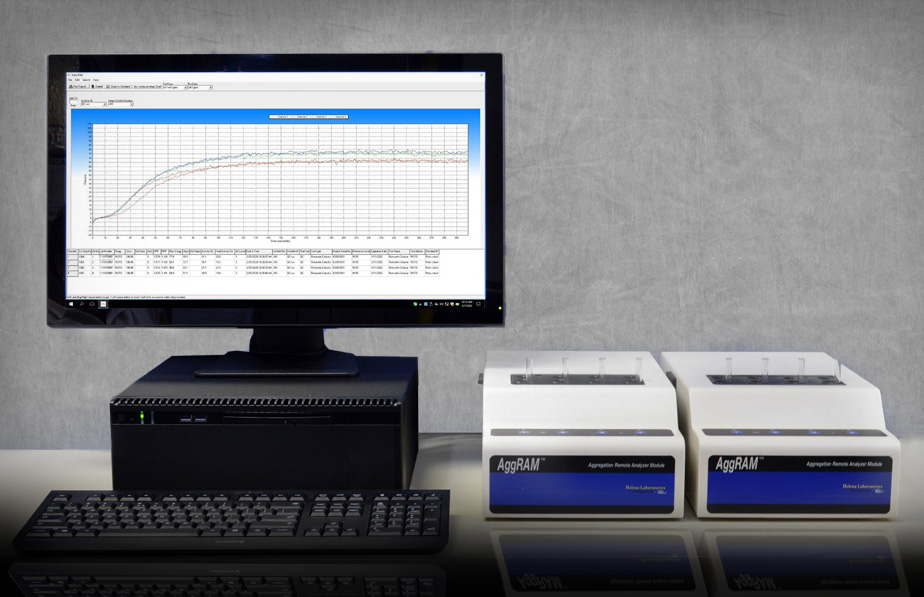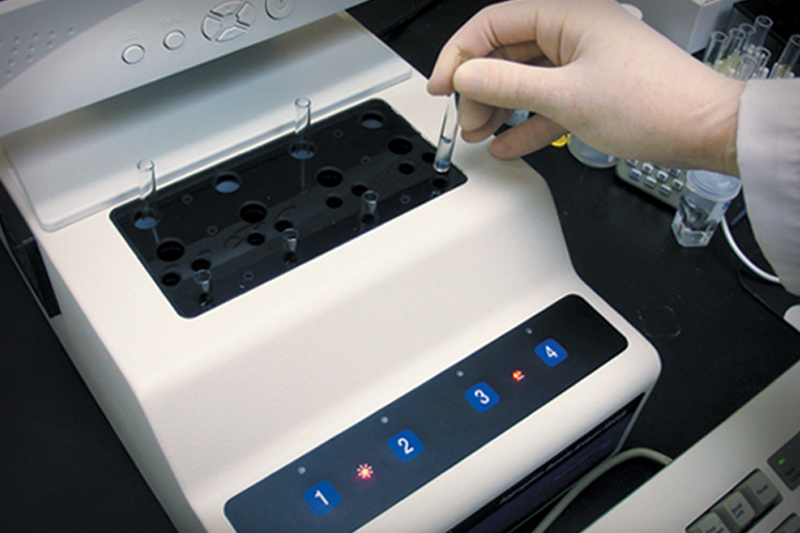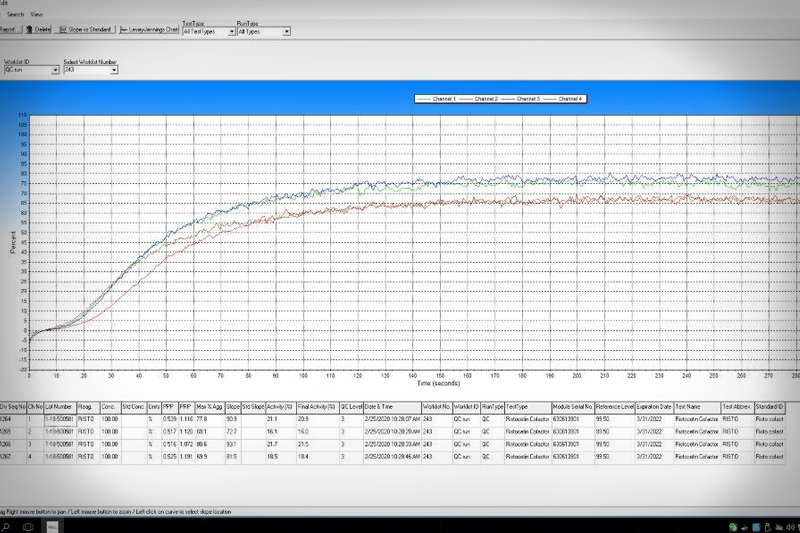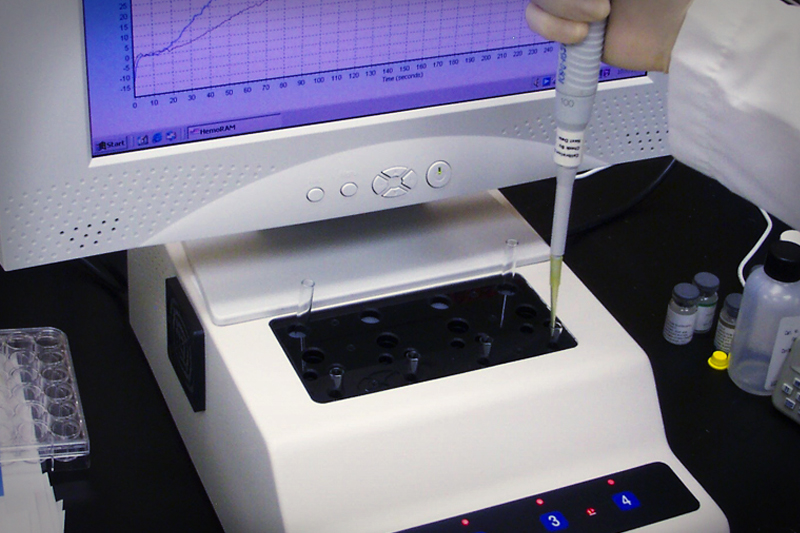
AggRAM - Advanced Modular System
The AggRAM, for platelet aggregation and ristocetin cofactor testing offers unsurpassed precision, ease of use and flexibility. AggRAM couples four-channel laser optic modules with a powerful Windows interface. Up to two modules can be run per Remote Analyzer computer, providing up to eight channels to handle your workload. Unlike the tungsten lamp optics of old, the AggRAM uses a laser diode to provide beautiful precision across all channels. Advanced optics coupled with an improved algorithm for slope calculation greatly improve precision for ristocetin cofactor testing. Upon start-up, AggRAM performs a laser balance check to ensure reproducibility day to day, year to year.

Data Handling Features
Automatically calculates slope and max % aggregation; displays and print lag phase; automatically calculates curves and smooths; reference overlay .

Customized Reports
Includes data from one channel or four, one patient or the whole run; pulls from data archives to profile patient results over time.

Quality Control
Evaluates and charts QC for ristocetin cofactor based on Westgard rules; generates Levy-Jennings charts, standard curves, etc with an integral action log.
Product No. / Item
1484 – AggRAM Analyzer1486 – AggRAM Module
1487 – AggRAM for Export
1667 – Barcode Reader and Cabling
1473 – Siliconized Cuvettes for AggRAM and PACKS-4 – 200/pkg
1479 – Scale Set Solutions (650 nm) for Platelet Assays – 1 each Low and High Calibrator
1489 – AggRAM Stir Bars – 30/pkg
9139 – Service Manual for AggRAM
Test Types:
Platelet Aggregation and Ristocetin CofactorAbsorbance Range:
0.0 to 2.0 O.D.Measuring Wavelength:
650 nmOptical Chambers per module:
Four chambers for combined or individual measurementsCuvettes:
8 mm x 60 mm (silicone coated glass)Stir Bars:
3.5 mm x 4 mm (coated magnet)Incubation and Reaction Temperature:
37°C +/-1°CGraphs:
-20% to 110% activity (+/- 0.5%) versus timeInstrument Operating Environment:
Ambient Temperature Range 15° to 30°C (59° to 86°F)Module Input Power:
110/220 Vac, 50/60 Hz, 1200 Watts MaximumModule Dimensions:
6" (15.24 cm) Tall x 10" (25.40 cm) Wide x 17" (43.18 cm) DeepModule Weight:
< 15 lbs (6.75 kg)Computer:
Intel Core i7 or equivalent processor, Microsoft - Windows 10 Professional x64, 8 GB RAM or higher, 500 GB Internal storage drive, LCD Monitor (800 x 600 or higher resolution), Keyboard and Mouse, Windows 10 Compatible Color Inkjet PrinterPlatelet Aggregation Reagents
Helena's platelet reagents provide outstanding stability and performance at affordable pricing. Reagents are optimized for use with AggRAM, but may be used on any turbidometric aggregometer of similar quality.
Platelet Aggregation Kit
Cat. No. / Item / Description
5369 – Platelet Aggregation Kit
Kit includes: 2 x 1 mL ADP Reagent, 2 x 1 mL Collagen Reagent and 2 x 1 mL Epinephrine Reagent
The Platelet Aggregation Kit is used to identify normal and abnormal platelet function, to quantitate platelet response and to determine the patient's response to anti-platelet drug therapy. The reagents are optimized for use with the Helena AggRAM analyzer, but may be used on any turbidometric aggregometer of similar quality.
ADP Reagent
Cat. No. / Item / Description
5366 – ADP – 2 x 1 mL
ADP is a lyophilized preparation of adenosine-5-diphosphate. ADP is for use in routine platelet aggregation studies for the evaluation of qualitative platelet function disorders. The concentration of the reconstituted ADP reagent is 200 μM.
Collagen Reagent
Cat. No. / Item / Description
5368 – Collagen – 2 x 1 mL
The collagen reagent is a clear, stabilized liquid reagent prepared from equine tendon, which is one of the world's best collagen preparations. Collagen is used in routine platelet aggregation studies for evaluation of qualitative platelet function disorders. The collagen reagent stock solution is reconstituted to a concentration of 100 μg/ml.
Epinephrine Reagent
Cat. No. / Item / Description
5367 – Epinephrine – 2 x 1 mL
Epinephrine is a lyophilized preparation of L-epinephrine bitartrate. Epinephrine is for use in routine platelet aggregation studies for evaluation of qualitative platelet function disorders. After reconstitution, epinephrine concentration is 3 mM.
Arachidonic Acid Reagent
Cat. No. / Item / Description
5364 – Arachidonic Acid – 2 x 1 mL
Arachidonic Acid is a lyophilized preparation of sodium arachidonate for use in platelet aggregation studies of abnormal function, especially dysfunction induced by aspirin and aspirin-containing medications. The concentration of the reconstituted reagent is 5 mg/mL.
Ristocetin Cofactor Reagents and Controls
Ristocetin Cofactor is more sensitive than RIPA to mild reductions in vWF and more often used to monitor therapy in vWD patients. Kit includes ristocetin, formalinized platelets, S.A.R.P., abnormal control and tris-buffered saline.
Helena Ristocetin Cofactor Assay Kit
Cat. No. / Item / Description
5370 – Ristocetin Cofactor Kit, 50 tests
Kit includes: 4 x 5 mL Lyophilized Platelets, 2 x 0.5 mL Ristocetin Cofactor Abnormal Control, 2 x 1 mL S.A.R.P. Assayed Reference Plasma, 2 x 1.5 mL Helena Ristocetin (10 mg/mL), 35 mL Tris-Buffered Saline
Ristocetin cofactor assays measure the ability of von Willebrand factor (Ristocetin cofactor) in the patient's plasma to agglutinate formalinized platelets in the presence of ristocetin. Decreased levels of ristocetin cofactor activity are associated with von Willebrand Disease.
Ristocetin (for Aggregation Assays)
Cat. No. / Item / Description
5199 – Ristocetin – 10 x 0.5 mL
This Ristocetin is for use in platelet aggregation studies for confirmation of von Willebrand Disease (vWD) and Bernard-Soulier Syndrome. Normal platelet-rich plasma exhibits a positive aggregation response to the addition of ristocetin using a final concentration of 12-15 mg/mL. The majority of vWD patients exhibit a negative response to ristocetin as do Bernard-Soulier patients.
Lyophilized Platelets
Cat. No. / Item / Description
5356 – Lyophilized Platelets – 5 x 10 mL
5371 – Lyophilized Platelets – 5 x 5 mL
Lyophilized Platelets are a standardized suspension of fixed platelets derived from platelet concentrate. Lyophilized Platelets are for use in the quantitation of ristocetin cofactor activity in plasma. The platelets are lyophilized for stability. Tris-Buffered Saline (Cat. No. 5365) should be used for reconstitution. The concentration of the reconstituted platelet suspension is approximately 200,000/mL. Platelets in Cat. No. 5356 show a slower reaction rate.
S.A.R.P. Specialty Assayed Reference Plasma
Cat. No. / Item / Description
5185 – S.A.R.P. – 10 x 1 mL
Coagulation S.A.R.P. was the first reference plasma fully assayed for virtually all coagulation studies. S.A.R.P. is prepared from a frozen pool of citrated plasma from healthy donors. S.A.R.P. has normal PT and aPTT clotting times and can be used as reference material for ristocetin and ristocetin cofactor assays.
Ristocetin Cofactor Abnormal Control Plasma
Cat. No. / Item / Description
5373 – Ristocetin Cofactor Abnormal Control – 5 x 0.5 mL
The control is to be used in the assay of ristocetin cofactor. It contains citrated human plasma with a level of ristocetin cofactor activity below 50%.
Ristocetin - 10 mg/mL (for Ristocetin Cofactor Assays)
Cat. No. / Item / Description
5372 – Ristocetin – 10 mg/mL, 5 x 1.5 mL
The reagent is to be used in the quantitative determination of ristocetin cofactor activity. The ristocetin reagent is prepared from Nocardia lurida and is used in the tests for von Willebrand Disease and Bernard-Soulier Syndrome.
Tris-Buffered Saline
Cat. No. / Item / Description
5365 – Tris-Buffered Saline – 1 x 125 mL
Tris-Buffered Saline is used for reconstitution and dilution of some of the reagents used in platelet aggregation assays and ristocetin cofactor assays.